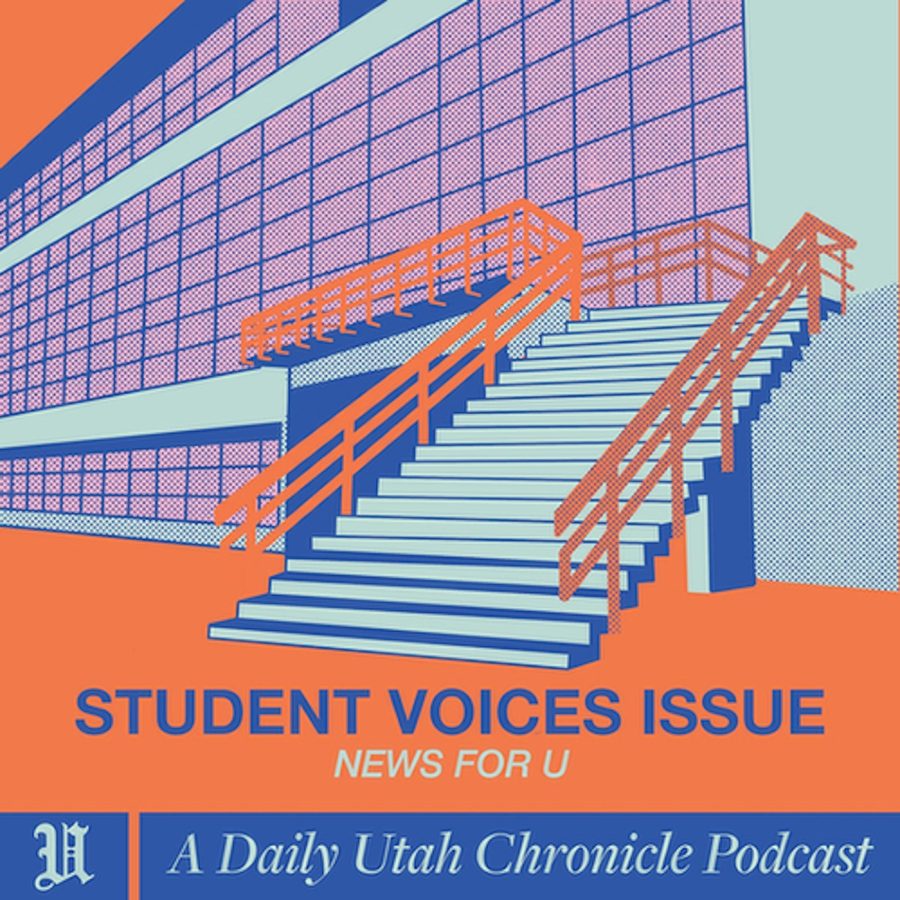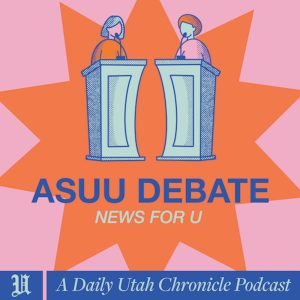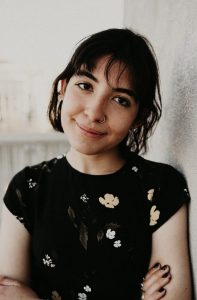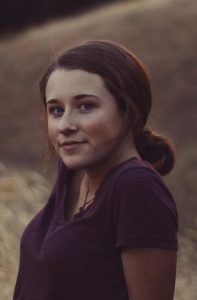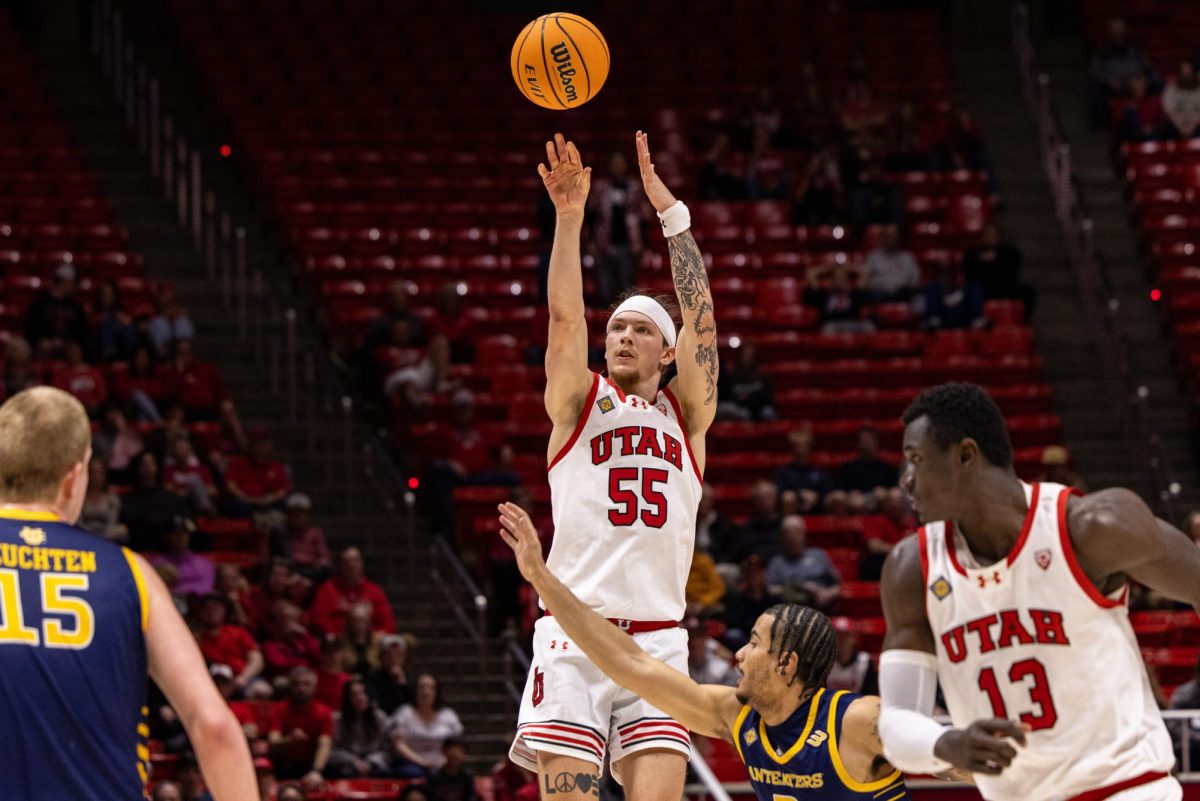News For U — Episode 3: Student Voices Print Issue
(Graphic by Sydney Stam | The Daily Utah Chronicle)
February 20, 2023
Emma 13:20:50
Hello, and welcome back to “News For U,” the Daily Utah Chronicle podcast. I’m Emma and today’s episode of our podcast will be on the print issue of the Chronicle. The latest issue just hit stands last Monday. The print issue is our physical newspaper that is distributed around campus. Each month a new issue is published. There are several locations around campus where the print issue can be found. A link will be provided in the show notes to locate a copy closest to you.
Today we are joined by Kayleigh Silverstein, who is the special projects managing editor and news writer. Kayleigh is going to talk a little bit about what went behind the creation of the print issue, where the idea came from, what it is about and more. Hi Kayleigh, we’re happy to have you on the podcast today.
Kayleigh Silverstein
Hi, thank you so much for having me.
Emma
Kayleigh, can you tell us a little bit about yourself and what you do here at the Chronicle?
Kayleigh Silverstein 13:21:40
Yeah, so I’m currently a senior, I’m in my last year, and I’ve been at the Chronicle since my freshman year. So I’ve been here for a minute. And my current position is special projects managing editor. That means I cover a few different areas. I’m in charge of awards, events, different special projects and the main thing would be print. And then I’ve been a news writer since my freshman year, which is really exciting. I love it at the news desk.
Emma 13:22:03
Nice. When did you start taking over print here at the Chronicle? And what have you accomplished since doing so?
Kayleigh Silverstein 13:22:10
I started taking over print in May 2022. And since then we have completed seven issues. And we are currently working on the eighth. And then the ninth is kind of where new leadership starts to take over. And I help guide them through that process. And then the cycle starts again. And two issues that I wanted to highlight today were our October and November issue. So October was our timeless issue, which was a super big undertaking. Half the stories were about the past, half were about the future. And we kind of had half the issue upside down, which sounds really confusing. But it was kind of this idea of time traveling, where a reader would pick up the issue, they would have one cover that was a photo of campus in the 1940s, they would flip through the issue, read stories about the past. And then they’d get to the center spread that our design director and photo director collaborated on, that was kind of this time warp in the middle. They would flip the issue upside down and then read into the future and have another cover that our photo director took in 2022 of campus. And that was just a really cool issue because it was more conceptual, and it was more creative, and it was all hands on deck to make that one work. And it was really cool in the end. And then the second issue I wanted to highlight was our November issue, which was all about collaboration. So this was different writing desks collaborating with other writing desks, this was different platforms collaborating with us. This was also a really cool collaboration with SLCC’s The Globe, that was a story all about water usage on different Utah campuses. And so that was just a really cool issue, because I think collaboration is a super important aspect of journalism. And it could not happen if you weren’t working with other people, and so we wanted to highlight that in an issue.
Emma 13:23:46
All right. And how do you choose the stories that are highlighted in the print issue?
Kayleigh Silverstein 13:23:50
So first, either myself or in collaboration with the Editor-in-Chief or some other key players, we kind of choose the theme for the issue. And then we tell all of our editors about the theme, and depending on how their desk works, they talk with their writers, and the writers pitch ideas to them, or they kind of assign stories to their writers, then they pitch to the Editor-in-Chief and I and we choose the stories based on if they’re evergreen, so if they stand the test of time and aren’t breaking news, and if they relate to the theme.
Emma 13:24:20
And what’s the process after the stories are chosen?
Kayleigh Silverstein 13:24:23
Yeah, so the writers have about three weeks to write their stories. So that means they’re doing research, they’re interviewing, they’re communicating with their editor. And then their editor does an edit on the stories and then it goes to copy and design and photo during this time, are designing page layouts. Photographers are going out taking photos communicating with writers to kind of do what the writer is envisioning. Then after that the Editor-in-Chief and I, we go in and we look at every story, it’s called proofing, and we go through and we edit them and we make sure they all look good together. And then after that we have our whole production meeting where everyone gets together, we look through the whole issue before sending it off to the printer. And basically what happens is we send it off that night and then in a few days, the following Monday, it’s out on stands.
Emma 13:25:07
Very cool. What is this month’s issue about? And where did the idea come from?
Kayleigh Silverstein 13:25:12
Yeah, so this month’s issue is called Student Voices. It’s all about amplifying different student voices on campus and different perspectives, and just trying to give the campus community a glimpse into student life.
Emma 13:25:24
That’s a great idea. Can you talk a little bit about exactly what is featured in this print issue?
Kayleigh Silverstein 13:25:29
Yeah, I can. So this print issue was all about features, which means these are longer form stories. They’re highlighting different people, groups, spaces that are around the Salt Lake Community. And so we had some really great stories this issue — news wrote a really cool feature on the new Arab Student Association and had some incredible quotes in there. Opinion did a feature on a student custodian and kind of their experiences on campus. Arts wrote a story about the underappreciation of arts at the U and did an interview with some students, which was super fascinating. And then sports did a feature on the MUSS with another incredible interview.
Emma 13:26:05
That sounds great. Can you tell us your favorite part of the issue that’s in stands now?
Kayleigh Silverstein 13:26:10
I think my favorite part of this issue is that there are three photo stories. We have, the first photo story is about the Dungeons & Dragons club, the second photo stories about first generation scholars and the third photo stories about ceramics at the U. And I think when we think of features in journalism, we often think about writing, but I think it’s really cool to also have some photo features in there to have a more visual component to the issue.
Emma 13:26:33
What do you hope students will gain from this issue in particular?
Kayleigh Silverstein 13:26:38
I hope when students pick up this issue, they are able to see different perspectives and read about different groups and different spaces that maybe they wouldn’t have previously known about.
Emma 13:26:49
Yeah. And can you tell me a little bit about future issues that you’re currently planning?
Kayleigh Silverstein 13:26:55
Yeah. So currently, we are in the process of our solutions journalism issue. And solutions journalism is a different framework of approaching a story where you’re writing about the solution to a social problem. So the story is all about that social response. And we’re having our writers focus on different solutions in the community, different ways people are making change. And then our final issue is going to be our farewell issue where we have all of our departing seniors write their farewells.
Emma 13:27:21
I love that. Why do you think it’s important for students to have a physical copy of the Chronicle’s stories?
Kayleigh Silverstein 13:27:28
I think it’s important for people to pick up that physical copy on campus because it is one way for students to engage in local journalism, which I think is important for every student to be doing so. And it’s also a way to kind of hold that paper and feel the work of so many people, feel the passion and creativity that went into that issue.
Emma 13:27:47
All right. Is there anything else you’d want to add today?
Kayleigh Silverstein 13:27:50
Yeah, I just want to say that my position would not be possible without the help of so many other people. I feel like we’re all just a very important piece of the puzzle. And everybody’s creativity and passion just makes this whole thing work, and so I just want to thank everyone at the Chronicle.
Emma 13:28:05
Thank you so much for joining us today, Kayleigh.
Kayleigh Silverstein 13:28:08
Thank you.
Emma 13:28:10
Make sure to pick up this month’s print issue at the location closest to you. Thank you so much for listening to today’s episode of the podcast. Don’t forget to tune into a new episode next week.
Executive Producer: [email protected] // @Sotertheadora
Host: [email protected] // @Eratkovic_news
Guest: [email protected] // @chronykayleigh


